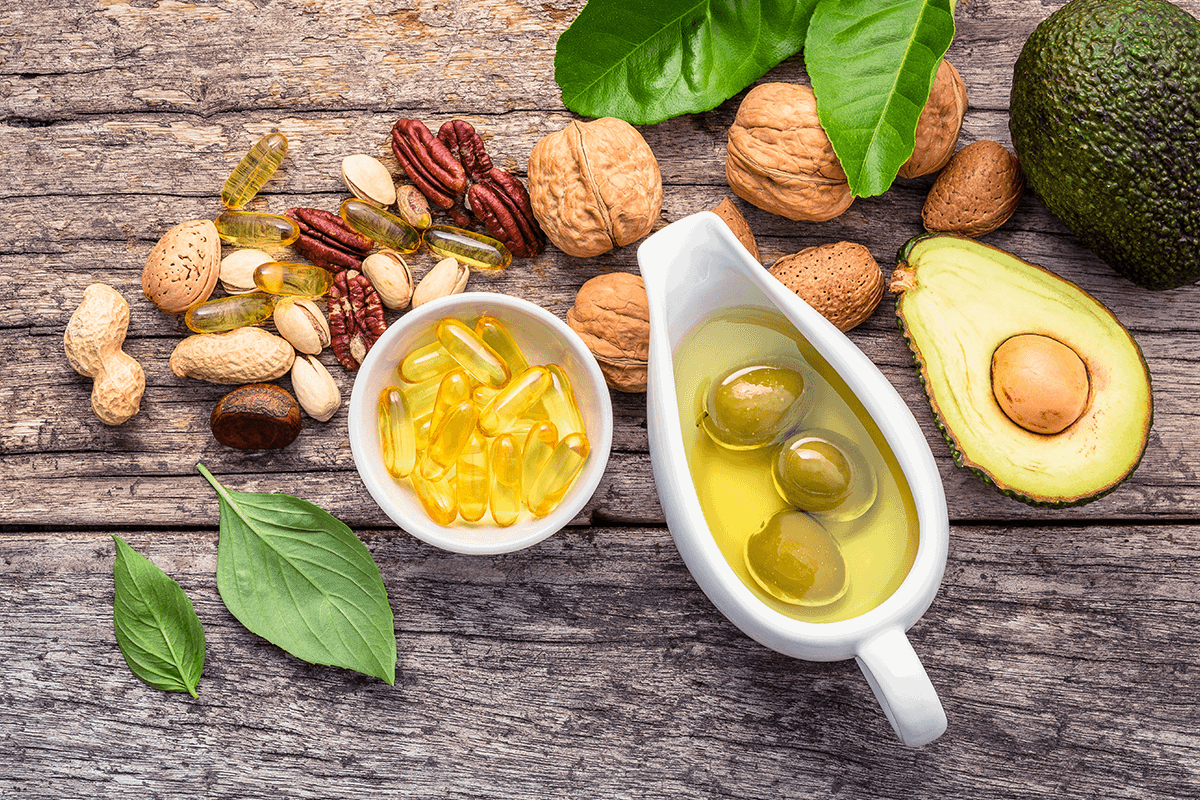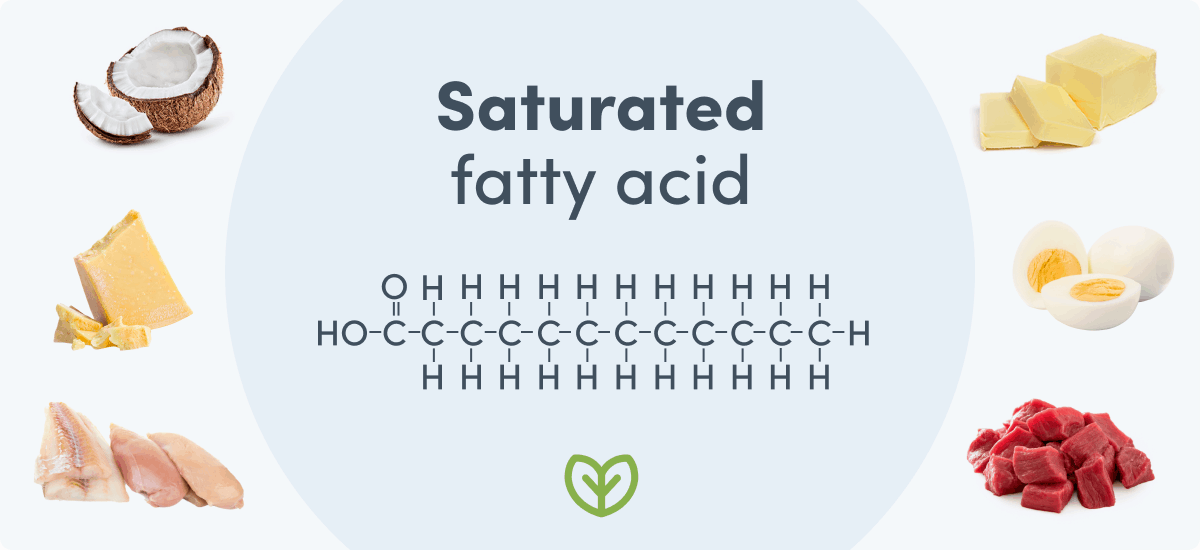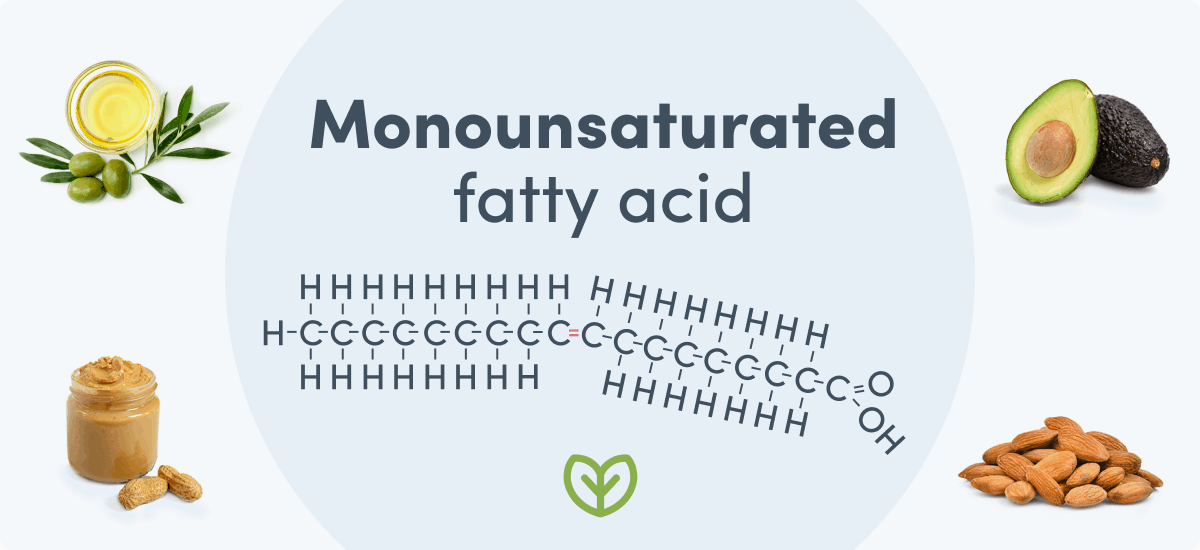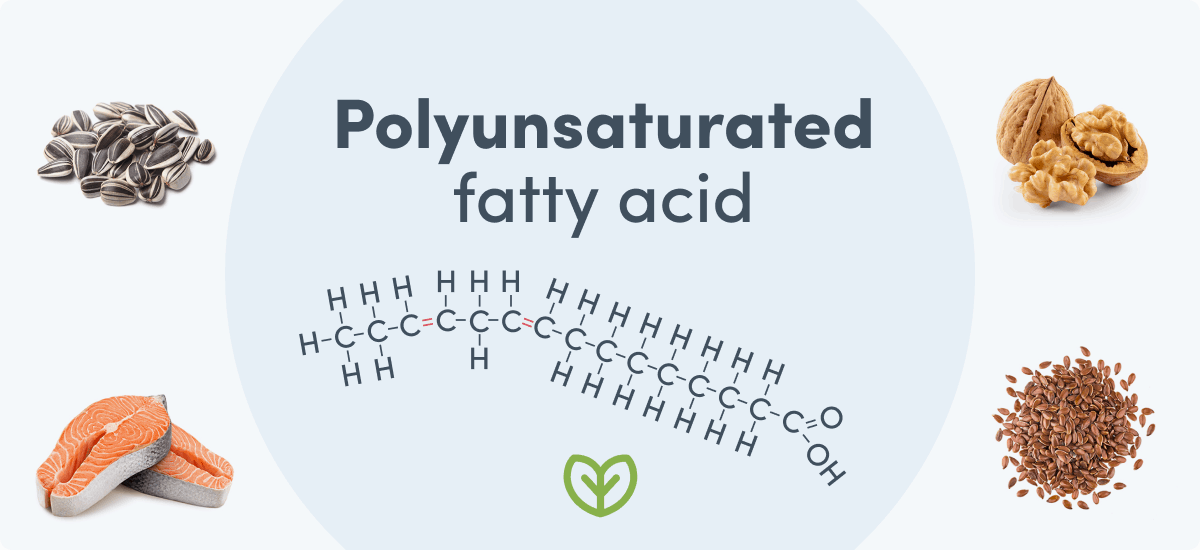
Dietary fat helps you to absorb nutrients like fat-soluble vitamins from your food.
Types of fat
Dietary fat is a macronutrient required by the body for essential functions, including nutrient absorption, cell growth, and hormone production. (1)(28) Fat is the most energy-dense of the three macronutrients (namely, carbohydrates, fat, and protein), containing approximately nine calories per gram. (28) Fats can generally be categorized into two groups: saturated and unsaturated. These terms refer to the chemical structure of the fatty acid, which dictates how they will act in the body and whether they will have health-promoting or detrimental effects.Saturated fat
The chemical structure of saturated fat features carbon chains that are entirely saturated by hydrogens and contain no double bonds between their carbons. As a result of their single bonds, molecules are packed tightly together and are more likely to be solid at room temperature. Saturated fat is primarily found in animal products and some plant-based foods, including:- Butter
- Cheese
- Coconut oil
- Eggs
- Meat and poultry (e.g., beef, pork, chicken)
- Palm oil (26)

Saturated fatty acids are largely found in animal products.
Unsaturated fat
The chemical structure of unsaturated fat includes a fatty acid chain with one or more double bonds, creating a kink in the chain. Unsaturated fats are more likely to be liquid at room temperature because the kink in the fatty acid chain prevents fat molecules from packing tightly together. Unsaturated fats are broken down into two categories, monounsaturated and polyunsaturated fats. (26)Monounsaturated fat
Monounsaturated fats have only one double bond in their carbon structure. Research has indicated that consuming monounsaturated fats may reduce cardiovascular risk factors by lowering low-density lipoprotein (LDL), sometimes referred to as “bad” cholesterol. (18) Top sources of monounsaturated fats include avocado, nuts, seeds, and olive oil. (29)
Olive oil and avocados are among the top dietary sources of monounsaturated fatty acids.
Polyunsaturated fat
Polyunsaturated fats have multiple double bonds, or kinks, in the carbon chain. Similarly to monounsaturated fats, polyunsaturated are known for their heart health benefits and have been shown to reduce LDL. (30) Top sources of polyunsaturated fats include flaxseeds, sunflower seeds, walnuts, and fish such as albacore tuna, herring, mackerel, salmon, and trout. (30) Two common types of polyunsaturated fats include omega-3 and omega-6 fatty acids. Omega-3 fatty acids contain multiple double bonds, with the first double-bond located on the third carbon. These fats are found in both animal and plant-based foods, such as fatty fish and walnuts. Omega-6 fatty acids also contain multiple double bonds, with the first double-bond found on the sixth carbon. These can be found in food (in the form of linoleic acid) or made in your body (arachidonic acid). (22)
Polyunsaturated fatty acids are found in many plant and animal-sourced foods, including nuts, seeds, and fatty fish.
Health benefits of fat
Dietary fat is necessary for numerous bodily functions. Described below are some of the most noteworthy functions and health benefits of fats.Nutrient absorption
During digestion, you need fat to absorb the four fat-soluble vitamins, A, D, E, and K. These micronutrients play many roles in your body, such as vision and immune support (vitamin A), bone health and development (vitamin D), cell damage protection and blood thinning (vitamin E), and blood clotting (vitamin K). (17) Next time you make a salad, make sure to include some healthy fats, such as an oil-based dressing, avocado, or nuts. One study investigated the effects of three salad dressings on the intestinal absorption of beta-carotene, a carotenoid and precursor to vitamin A. The greatest carotenoid absorption was observed after participants consumed a vegetable salad with full-fat salad dressing versus a reduced-fat dressing. Virtually zero absorption of carotenoids was observed when participants ate their salad with a fat-free dressing. (5)Brain and mental health
Consuming certain sources of fat can help prevent chronic mental health issues and disease. A double-blind, randomized study found that omega-3 fatty acids help improve executive function and structural neuroimaging of the brain in older adults. (32) This indicates that consuming healthy fat can help keep your mind stay sharp during aging. Additionally, people who regularly consume fish or omega-3s have a 20% lower risk of depression than individuals who do not regularly consume fish. (3) Many complicated factors contribute to depression, however, proper nutrition may help prevent or address depressive symptoms.Did you know? Approximately 60% of your brain is fat. (7)
Skin health
Dietary fat plays an essential role in skin health by assisting in damage repair and maintaining epidermal barrier function and membrane structure. (6) As you age, you begin to lose fat beneath the skin on your face which contributes to visible signs of aging such as wrinkles and skin sagging. (6) Some research suggests that consuming monounsaturated fats may help reduce the risk of developing severe facial skin photoaging from oxidative stress and ultraviolet radiation exposure. These results are believed to be due in part to the anti-inflammatory effects of monounsaturated fats. (14) Furthermore, linoleic acid (LA), a type of omega-6 fatty acid found primarily in plant-based foods, is an important component of your skin. It helps form the epidermal barrier, which protects from environmental factors and prevents water loss through the skin. (12) LA can be found in sunflower seeds, pecans, pine nuts, and some cheeses.Did you know? Fat can support weight loss as it’s known to stabilize blood sugar and keep you satiated. (20)(21)
Appetite and blood sugar management
Dietary fat has been found to regulate appetite through several mechanisms. It impacts the release of hormones that affect appetite and inhibits gastric emptying, thus improving postprandial (post-meal) glycemic control and increasing satiety. A trial study in diabetic patients found that gastric emptying was delayed and the rise of blood glucose and insulin was reduced when consuming olive oil before a carbohydrate-containing meal. (10) These effects suggest that fat may be beneficial for weight management and, potentially, metabolic disorders.
Foods high in omega-3s help to reduce inflammation in your body.
Healthy high-fat foods
Choose from the following foods when adding more fat to your diet.Extra virgin olive oil
Extra virgin olive oil (EVOO) is produced without chemical processes and is mostly composed of monounsaturated fat. EVOO is a source of antioxidant-rich plant compounds known as polyphenols. This antioxidant capacity has been linked to protection against coronary artery disease and cancer. (11)Avocados
This creamy, high-fat fruit is an excellent source of monounsaturated fat and vitamin E, a fat-soluble vitamin and antioxidant. Avocado oil is a suitable oil for cooking at high temperatures because it has a higher smoke point. (8)Coconut and MCT oils
The fat in coconut contains medium-chain triglycerides (MCTs), a form of fat that is easily digested due to its shorter fatty acid chain. MCT oil, an excellent source of energy extracted from coconut or palm fruit, is also available as a dietary supplement. One study compared the metabolic effects of supplementing with MCT oil versus olive oil as part of a 16-week weight loss program. Following the intervention, subjects lost more weight while supplementing with MCT oil than with olive oil, without increasing triglyceride levels and other metabolic markers. (24)Fatty fish
Fatty fish, such as trout, salmon, mackerel, herring, sardines, and anchovies, are an excellent source of omega-3 fatty acids, high in EPA and DHA. (16) Consuming fatty fish may improve cardiovascular health and reduce cardiovascular risk factors, such as high blood pressure and high cholesterol. (9)Eggs
Eggs are rich in fat-soluble vitamins A, D, E, and K and provide protein with a full spectrum of amino acids. (13) Don’t throw away the yolk – that’s where the healthy fat is stored. In one study comparing the benefits of consuming whole eggs versus a yolk-free egg substitute, whole eggs were more effective in raising high-density lipoprotein (HDL) levels, commonly referred to as “healthy” cholesterol. (4)Nuts and seeds
Nuts, such as walnuts, almonds, Brazil nuts, and seeds, including flax and chia seeds, are great sources of healthy monounsaturated and polyunsaturated fats. Many nuts and seeds also provide essential alpha-linolenic acid, minerals, fiber, and other nutrients. (16) According to multiple meta-analyses, regularly consuming nuts and seeds may improve health outcomes by lowering blood pressure, (15) reducing LDL cholesterol levels, (19) and improving glycemic control in patients with type 2 diabetes. (31)The bottom line
Dietary fat benefits your overall health in numerous ways, including optimizing nutrient absorption and supporting brain and skin health. Take advantage of these health benefits by eating a variety of healthy high-fat foods, such as nuts, seeds, fish, eggs, and healthy oils daily.- American Heart Association. (n.d.-a). Dietary fats. Retrieved December 21, 2020, from https://www.heart.org/en/healthy-living/healthy-eating/eat-smart/fats/dietary-fats
- American Heart Association. (n.d.-b). Saturated Fat. Retrieved December 21, 2020, from https://www.heart.org/en/healthy-living/healthy-eating/eat-smart/fats/saturated-fats
- Bentsen, H. (2017). Dietary polyunsaturated fatty acids, brain function and mental health. Microbial Ecology in Health and Disease, 28(sup1), 1281916.
- Blesso, C. N., Andersen, C. J., Barona, J., Volek, J. S., & Fernandez, M. L. (2013). Whole egg consumption improves lipoprotein profiles and insulin sensitivity to a greater extent than yolk-free egg substitute in individuals with metabolic syndrome. Metabolism, 62(3), 400–410.
- Brown, M. J., Ferruzzi, M. G., Nguyen, M. L., Cooper, D. A., Eldridge, A. L., Schwartz, S. J., & White, W. S. (2004). Carotenoid bioavailability is higher from salads ingested with full-fat than with fat-reduced salad dressings as measured with electrochemical detection. The American Journal of Clinical Nutrition, 80(2), 396–403.
- Cao, C., Xiao, Z., Wu, Y., & Ge, C. (2020). Diet and skin Aging—From the perspective of food nutrition. Nutrients, 12(3), 870.
- Chang, C., Ke, D., & Chen, J. (2009). Essential fatty acids and human brain. Acta Neurol Taiwan, 18(4), 231–241.
- Flores, M., Saravia, C., Vergara, C., Avila, F., Valdés, H., & Ortiz-Viedma, J. (2019). Avocado oil: Characteristics, properties, and applications. Molecules, 24(11), 2172.
- Gammone, M., Riccioni, G., Parrinello, G., & D’Orazio, N. (2018). Omega-3 polyunsaturated fatty acids: Benefits and endpoints in sport. Nutrients, 11(1), 46.
- Gentilcore, D., Chaikomin, R., Jones, K. L., Russo, A., Feinle-Bisset, C., Wishart, J. M., Rayner, C. K., & Horowitz, M. (2006). Effects of fat on gastric emptying of and the glycemic, insulin, and incretin responses to a carbohydrate meal in type 2 diabetes. The Journal of Clinical Endocrinology & Metabolism, 91(6), 2062–2067.
- Gorzynik-Debicka, M., Przychodzen, P., Cappello, F., Kuban-Jankowska, A., Marino Gammazza, A., Knap, N., Wozniak, M., & Gorska-Ponikowska, M. (2018). Potential health benefits of olive oil and plant polyphenols. International Journal of Molecular Sciences, 19(3), 686.
- Kendall, A. C., Kiezel-Tsugunova, M., Brownbridge, L. C., Harwood, J. L., & Nicolaou, A. (2017). Lipid functions in skin: Differential effects of n-3 polyunsaturated fatty acids on cutaneous ceramides, in a human skin organ culture model. Biochimica et Biophysica Acta (BBA) – Biomembranes, 1859(9), 1679–1689.
- Kuang, H., Yang, F., Zhang, Y., Wang, T., & Chen, G. (2018). The impact of egg nutrient composition and its consumption on cholesterol homeostasis. Cholesterol, 2018, 1–22.
- Latreille, J., Kesse-Guyot, E., Malvy, D., Andreeva, V., Galan, P., Tschachler, E., Hercberg, S., Guinot, C., & Ezzedine, K. (2012). Dietary monounsaturated fatty acids intake and risk of skin photoaging. PLoS ONE, 7(9), e44490.
- Mohammadifard, N., Salehi-Abargouei, A., Salas-Salvadó, J., Guasch-Ferré, M., Humphries, K., & Sarrafzadegan, N. (2015). The effect of tree nut, peanut, and soy nut consumption on blood pressure: A systematic review and meta-analysis of randomized controlled clinical trials. The American Journal of Clinical Nutrition, 101(5), 966–982.
- National Institutes of Health. (2020, October). Omega-3 Fatty Acids. https://ods.od.nih.gov/factsheets/Omega3FattyAcids-Consumer/
- National Research Council (US) Committee on Diet and Health. (1989b). Fat-Soluble Vitamins. In Diet and health: Implications for reducing chronic disease risk (p. 11).
- National Research Council (US) Committee on Diet and Health. (1989a). Fats and other lipids. In Diet and health: Implications for reducing chronic disease risk. (p. 7).
- Pan, A., Yu, D., Demark-Wahnefried, W., Franco, O. H., & Lin, X. (2009). Meta-analysis of the effects of flaxseed interventions on blood lipids. The American Journal of Clinical Nutrition, 90(2), 288–297.
- Ramel, A., Martinéz, A., Kiely, M., Morais, G., Bandarra, N. M., & Thorsdottir, I. (2008). Beneficial effects of long-chain n-3 fatty acids included in an energy-restricted diet on insulin resistance in overweight and obese European young adults. Diabetologia, 51(7), 1261–1268.
- Samra, R. A. (2010). Fats and satiety. In Boca Raton (FL): CRC Press/Taylor & Francis (Ed.), Fat detection: Taste, texture, and post ingestive effects (p. 15).
- Simopoulos, A. P. (2002). The importance of the ratio of omega-6/omega-3 essential fatty acids. Biomedicine & Pharmacotherapy, 56(8), 365–379.
- Siri-Tarino, P. W., Sun, Q., Hu, F. B., & Krauss, R. M. (2010). Meta-analysis of prospective cohort studies evaluating the association of saturated fat with cardiovascular disease. The American Journal of Clinical Nutrition, 91(3), 535–546.
- St-Onge, M.-P., Bosarge, A., Goree, L. L. T., & Darnell, B. (2008). Medium chain triglyceride oil consumption as part of a weight loss diet does not lead to an adverse metabolic profile when compared to olive oil. Journal of the American College of Nutrition, 27(5), 547–552.
- U.S. Department of Agriculture. (n.d.-a). 2015-2020 dietary guidelines: Answers to your questions. https://www.choosemyplate.gov/node/5679
- U.S. Department of Agriculture. (n.d.-b). Saturated, unsaturated, and trans fats. Retrieved December 21, 2020, from https://www.choosemyplate.gov/node/5664
- U.S. National Library of Medicine. (2015, March). Dietary fats. https://medlineplus.gov/dietaryfats.html
- U.S. National Library of Medicine. (2020a, December). Dietary fats explained. https://medlineplus.gov/ency/patientinstructions/000104.htm
- U.S. National Library of Medicine. (2020b, December). Facts about monounsaturated fats. https://medlineplus.gov/ency/patientinstructions/000785.htm
- U.S. National Library of Medicine. (2020c, December). Facts about polyunsaturated fats. https://medlineplus.gov/ency/patientinstructions/000747.htm
- Viguiliouk, E., Kendall, C. W. C., Blanco Mejia, S., Cozma, A. I., Ha, V., Mirrahimi, A., Jayalath, V. H., Augustin, L. S. A., Chiavaroli, L., Leiter, L. A., de Souza, R. J., Jenkins, D. J. A., & Sievenpiper, J. L. (2014). Effect of tree nuts on glycemic control in diabetes: A systematic review and Meta-Analysis of randomized controlled dietary trials. PLoS ONE, 9(7), e103376.
- Witte, A. V., Kerti, L., Hermannstädter, H. M., Fiebach, J. B., Schreiber, S. J., Schuchardt, J. P., Hahn, A., & Flöel, A. (2013). Long-Chain omega-3 fatty acids improve brain function and structure in older adults. Cerebral Cortex, 24(11), 3059–3068.





